Bullock’s Oriole (Icterus bullockii) is a medium-sized songbird found in western North America. Males boast a striking black and orange-yellow plumage, while females have a more subdued appearance.
Their ranges overlap with a few similar oriole species, so here is some more information about them if you’re unsure which species you saw.
Identification
Bullock’s Orioles have sleek yet sturdy bodies, measuring 6.7-7.5 inches long with a wingspan of 12.2 inches. They have medium-long tails that are slightly notched when the bird is perching. Their gray bills are wide at the base and converge into a sharp point at the tip and their eyes are dark, almost black.
Male
The plumage of male Bullock’s Orioles is a striking combination of yellowish orange and black. They have almost entirely golden orange undersides except for a black throat patch. Their heads are the same bright orange with a black stripe through their eyes that connects to their black cap. The back, wings, and upperside of their tail are also black. However, their wings have a rather large white patch.
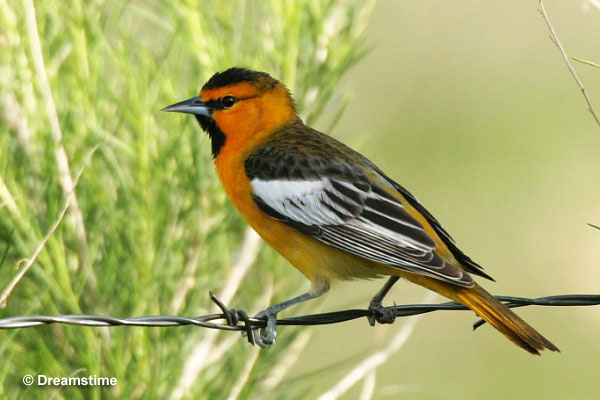
Immature males look more similar to females. They have duller plumage, grayish-olive instead of black coloring, grayish lower belly and rump, and almost completely yellow tail feathers. You can still distinguish them from females by their black throat patch and the dark stripe through their eyes.
Female
The female Bullock’s Oriole has an overall similar but more understated and muted appearance compared to the striking colors of the male. They have a pale dull yellow head, throat, upper chest, and tail. Their upperparts are grayish-brown, their crown olive, and their underside whitish. They have dark wings with two white wingbars.
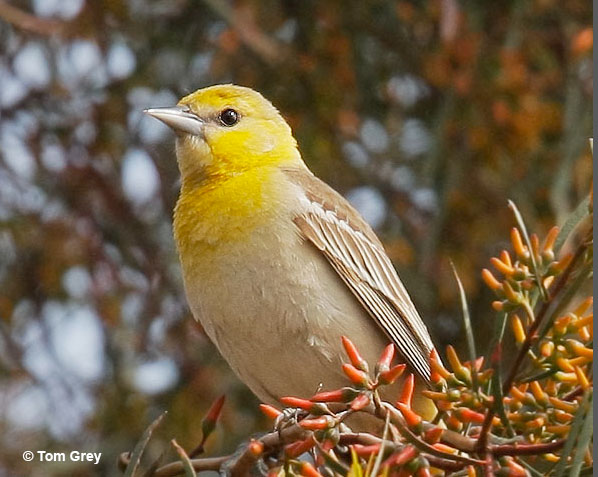
Juvenile Bullock’s Orioles resemble females, as do immatures, but juveniles have darker wings than females. Their bills are pink or whitish instead of darker grayish.
Vocalizations
Both male and female Bullock’s Orioles sing, and their songs are quite similar. However, females’ singing sounds slightly harsher and is a bit lower in pitch. Additionally, females generally sing from the ground, whereas males in trees.
The songs are energetic, lasting about 3 seconds, and are composed of whistles, rattles, and liquid notes.
There are two distinct songs. The first one can be described as kip, kit-tick, kit-tick, whew, wheet, and the second one as cut cut cudut whee up chooup.
Bullock’s Orioles have two types of calls. Their chatter call is made up of rapid and harsh rattles. This is given to raise alarm or maintain contact or when mobbing. The other call is a simple and sharp one-noted chip.
Food
Bullock’s Oriole’s diet is varied and consists of both plant and animal matter. Insects constitute a significant portion of their diet. They feed on a variety of flying and crawling insects, including butterflies and their larvae, beetles, caterpillars, grasshoppers, wasps, bugs, crickets, weevils, spiders, and more. Occasionally, they will also eat mollusks and small lizards.
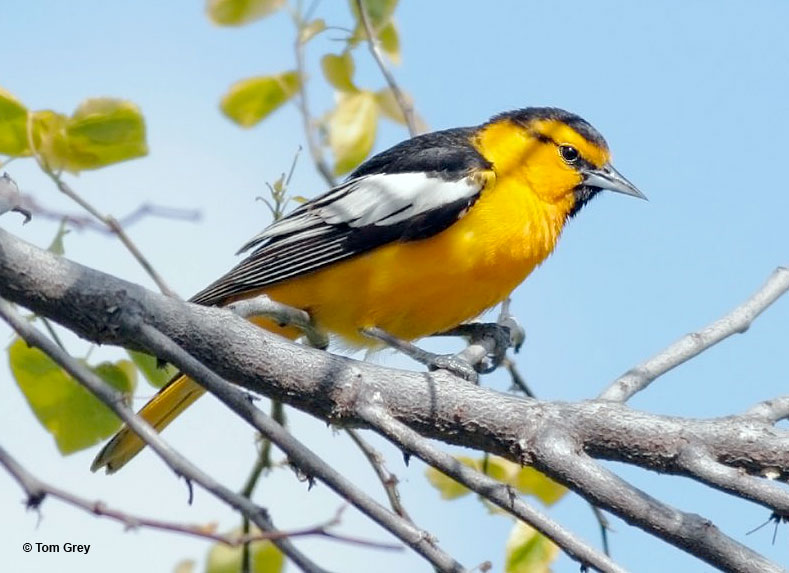
Bullock’s Orioles also consume nectar from various flowers such as agaves and eucalyptus. Fruits, berries, and soft mast make up another part of their diet. They favor blackberries, cherries, raspberries, and figs.
Bullock’s Orioles are known for their active and agile foraging behavior. They may search for insects among foliage, often using their sharp bills to glean insects from leaves and branches. Sometimes they catch their prey mid-air. Orioles also visit orchards and gardens, where they may take advantage of human-provided food sources. This can include offerings such as sugar water from hummingbird feeders.
Nesting and Eggs
Bullock’s Orioles are monogamous, but they only pair up for one breeding season and may take a new mate for the next one. Males arrive on the breeding grounds before the females, establish a territory, and sing to defend it.
Their courtship display includes the male hopping from branch to branch, bowing to the female, stretching upright, spreading tail feathers, and quivering his wings while calling every so often.
After pairing up, the female chooses a nesting site, which is often near water at the edge of a woodland or in an isolated tree 10-25 feet above the ground. Bullock’s Oriole nests are hanging pouches often suspended from the tips of flexible and slender branches of deciduous trees.
Males help with gathering the material while females are primarily responsible for the actual building part. The nest is woven of vine tendrils, flexible yet durable plant fibers, strips of bark, grasses, and yarn and is lined with plant down, hair, moss, and fine grass.
Bullock’s Orioles have 3-7, mostly 4-5 eggs in a clutch. The eggs are bluish-white to pale gray with dark blotches, measuring 0.8-1.1 inches long and 0.6-0.7 inches wide. Females incubate the eggs for around two weeks. After the young have hatched, both parents take care of them by feeding them and defending the nest from predators. The young stay in the nest for about two weeks.
Current Situation
Bullock’s Orioles range throughout most of Mexico and western North America. They winter in Mexico and migrate to the western United States and southmost western Canada for the breeding season.
Bullock’s Orioles prefer semi-open habitats, such as riparian and open woodlands, parks, scrub forests, and riverside groves.
They prefer to nest in deciduous trees in areas dominated by cottonwood, pecan, oaks, and sycamores. On their wintering grounds, they can also be found in pine, fir, and pine-oak forests.
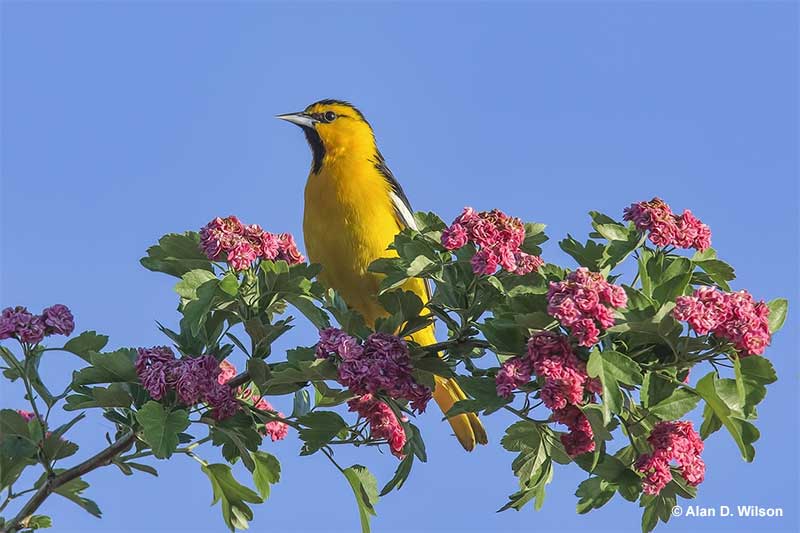
Bullock’s Oriole is listed as a species of least concern on the IUCN Red List. It is a common species with a relatively stable, although slightly declining population. They are most threatened by the loss of riparian habitats due to groundwater depletion and the loss of prey insects due to pesticides.
Facts
- Bullock’s Oriole’s and Baltimore’s Oriole’s ranges overlap in the Great Plains. In the past, they were thought to be one species, the Northern Oriole. The two species also hybridize.
- The word “oriole” has Latin roots and comes from Latin word aureolus, which means golden, referring to their generally yellow to flame orange plumage.
- Although Bullock’s Orioles generally range only throughout the western United States, then they can end up in the eastern United States during fall.
- Bullock’s Orioles, and orioles in general are attracted to the color orange. If you want to attract these birds to your backyard, get orange bird feeders. Keep in mind that they don’t eat regular bird seed but will feed on mealworms and sugar water. You can also try fruits or jelly!
- The oldest Bullock’s Oriole on record lived to be 8 years and 11 months old. However, most individuals do not live this long.
Similar Species
These vibrant birds have various similar species. The species most similar to them belong to the same genus as they do – Icterus. They have very similar coloration and plumage patterns, but if you get a good look, then it shouldn’t be too hard to tell them apart. Here are the three species most similar to them and how to tell them apart.
Baltimore Oriole
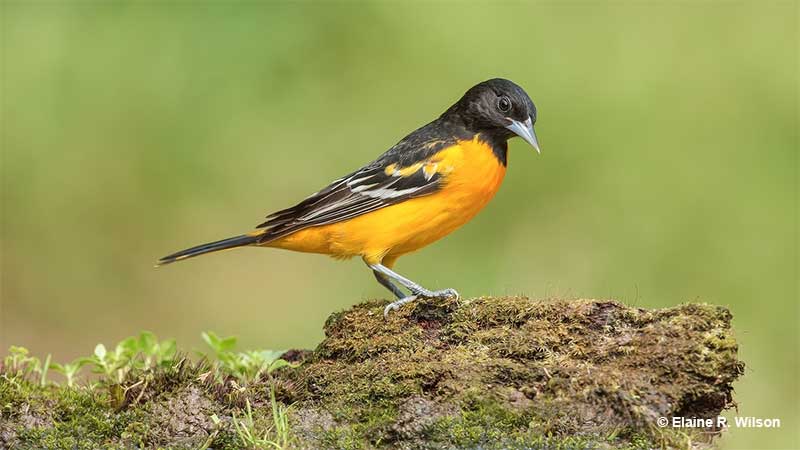
Baltimore Orioles are light orange on the underside and black on the upper side. They have a completely black head and black wings with white wingbars. Females are dull yellow to slightly brownish overall, with more brown on the back and dark but dull wings with similar white patterning to the males.
An easy way to tell the males apart is to look at their heads and wings. Male Bullocks have a black eye stripe and cap but otherwise orange heads whereas male Baltimores have a completely black head. Bullock males have a white wing patch whereas Baltimores have less white and only have white wing bars.
Female Bullocks have a grayish back and underside whereas female Baltimores are yellowish all over and have brown mottling on their backs.
Hooded Oriole
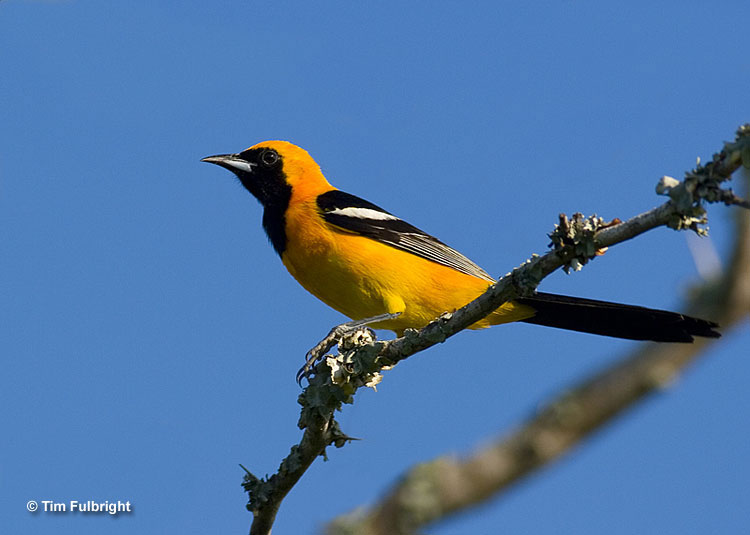
Hooded Orioles range throughout Mexico and in the southwestern United States. Male Hooded Orioles are yellow to light orange overall with a black back, tail, bill, face, and throat patch. Their wings are also black with white wingbars. Females are noticeably more modest and are pale yellow all over with a bit of gray to their backs and light gray wings and white wingbars.
Males are fairly easy to distinguish if you get a good look at their faces. Male Bullocks have a black cap and eye stripe whereas male Hooded Orioles have a black face but an orange hood. Female Hooded orioles are yellow overall, whereas female Bullocks have whitish bellies and grayish backs.
Orchard Oriole

Male Orchard Orioles are black above, chestnut-brown below, and have a chestnut patch on the wings. Females are pale yellow on the underside and slightly olive-yellow on the upperside. They have dark wings with white wingbars.
Males are easy to distinguish as male Bullocks have yellow and light orange in their plumage whereas male Orchards have chestnut-brown. When it comes to females, then Orchard Orioles have a more uniform and greenish plumage. Female Bullocks have a whitish belly and grayish backs as opposed to the yellow belly and greenish-yellow back of the female Orchards.
FAQ
How big are Bullock’s Orioles?
Bullock’s Orioles are medium-sized songbirds, measuring 6.7-7.5 inches long.
How do you identify a Bullock’s Oriole?
The easiest way to identify a Bullock’s Oriole is by their plumage. Males are yellow-orange with a black cap, throat patch, back, line through the eye, and wings with a white wing patch. Females are whitish below, grayish on the back, have dark wings with white wingbars and have yellow heads, chests, and tails.
What is the difference between Bullock’s Oriole and the Baltimore Oriole?
Bullock’s and Baltimore Orioles generally range throughout the western and eastern United States respectively. Male Bullock’s Orioles have a yellow face, black cap, throat patch, and stripe through the eye whereas male Baltimore Orioles have an overall black head and less white on the wings. Female Bullock’s Orioles have a whitish belly and grayish back whereas female Baltimore’s Orioles are overall yellowish.
Why are they called Bullock’s Orioles?
Bullock’s Oriole was named by William Swainson in honor of William Bullock, Swainson’s sponsor.

